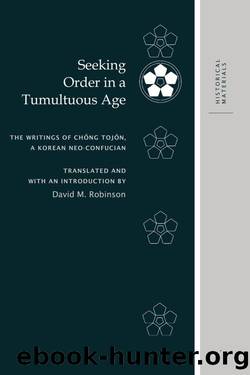Seeking Order in a Tumultuous Age (Korean Classics Library: Historical Materials) by David M. Robinson

Author:David M. Robinson [Robinson, David M.]
Language: eng
Format: epub
ISBN: 9780824859466
Publisher: University of Hawaii Press
Published: 2016-08-31T07:00:00+00:00
Chapter Four: A Literary Mirror to Order the World: Part Two
Censorate èºå®
Offices of the Zhou: The censor å¾¡å² oversaw the governing of the myriad people. He was ordered to assist the grand steward å¢å®°.
During the Qin dynasty, the censor supervised commandaries. Thus, it had the name âto supervise and inspect.â
During the early Han dynasty, censors were used to investigate those who did not adhere to ritual protocol. Censors-in-chief 御å²å¤§å¤« assisted councilors-in-chief ä¸ç¸ in concurrently regulating the myriad affairs of state. The vice-censor-in-chief ä¸ä¸ resided within the palace and oversaw the imperial library. The attendant censor ä¾å¾¡å² received memorials from ministers and impeached wayward officials. The place where their offices were located was called the Pavilion of the Censors 御å²èº or the Court of the Orchid Pavilion èèºå¯º.
During the Latter Han, vice-censors-in-chief were dispatched on regional tours, exclusively tasked with investigation and impeachment. Although initially they were not in charge of memorials to the throne, they nevertheless sat in seats specially reserved for their use. Their duties were grave. They enforced the law [for] the throne. The influential and favored feared them. [The censorsâ] powers were focused, and their responsibilities heavy.
During the Song dynasty (420â479), there was a single vice-censorin-chief.467 Each month on the twenty-fifth day, he would circumambulate the palace walls. He and the director of the Department of State Affairs å°æ¸ divided the road. Even if he encountered a vice-minister ä¸é leaving court, he still had the right of way. The remainder of the myriad officials at court and in the provinces had to stop their horses.
During the Latter Wei å¾é (386â534), the palace commandant of censors 御å²ä¸å° supervised officialdom.468 Whenever he left or returned from the palace, the roads were cleared. The nobles and officials all parted along the road. The remainder of the officials dismounted from their horses and stopped their carriages on the side of the road. After the Eastern Wei æ±é (534â550) moved to Ye, this practice was not revived.469
The Northern Qi åé½ dynasty (550â577) revived former practices. All officials in the capital region commanding troops in the infantry and cavalry were subordinate to [the Censorate]. Since the Qi é½ (479â502) and Liang dynasties, the Censorate has been called the Southern Pavilion.
During the Latter Zhou å¾å¨ (951â960), the Censorate was called Office of Fundamental Laws å¸æ².
During the Tang dynasty, it was also called the Pavilion of the Censorate. Under the former system, [the censor] had no more than the responsibility for investigation and supervision. Late in the Zhenguan reign period (627â649), when Li Qianyou æä¹¾ç¥ (d. 668) served as vice-censor-in-chief, he submitted a memorial [requesting] the establishment of a prison within the offices of the Censorate and secured control over punishments. Only during the Yonghui 永徽 reign (650â655), when Cui Yuanmao å´å è served as grand master, did it adjudicate legal cases. [Thus] it was only after the Tang dynasty that the Censorate came to oversee punishments and legal cases in addition to impeachment.
During the early Tang dynasty, the power of the Censorate was great. The
Download
This site does not store any files on its server. We only index and link to content provided by other sites. Please contact the content providers to delete copyright contents if any and email us, we'll remove relevant links or contents immediately.
The Rape of Nanking by Iris Chang(3517)
The Sympathizer by Viet Thanh Nguyen(3483)
World without end by Ken Follett(3006)
Ants Among Elephants by Sujatha Gidla(2925)
Blood and Sand by Alex Von Tunzelmann(2609)
Japanese Design by Patricia J. Graham(2556)
City of Djinns: a year in Delhi by William Dalrymple(2136)
Inglorious Empire by Shashi Tharoor(2102)
Foreign Devils on the Silk Road: The Search for the Lost Treasures of Central Asia by Peter Hopkirk(2056)
In Order to Live: A North Korean Girl's Journey to Freedom by Yeonmi Park(2053)
Tokyo by Rob Goss(2018)
India's Ancient Past by R.S. Sharma(1988)
India's biggest cover-up by Dhar Anuj(1983)
The Great Game: On Secret Service in High Asia by Peter Hopkirk(1961)
Tokyo Geek's Guide: Manga, Anime, Gaming, Cosplay, Toys, Idols & More - The Ultimate Guide to Japan's Otaku Culture by Simone Gianni(1947)
Goodbye Madame Butterfly(1934)
The Queen of Nothing by Holly Black(1754)
Living Silence in Burma by Christina Fink(1731)
Batik by Rudolf Smend(1720)
